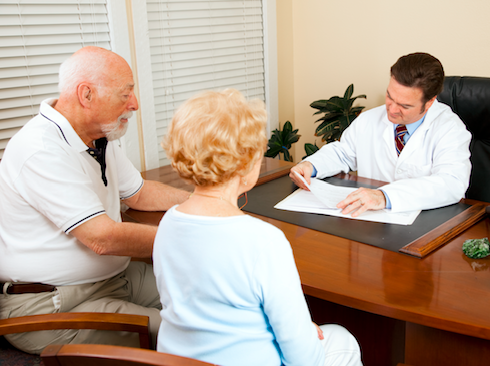Communicating About Cancer: A Brief Guide to Telling People Who Care
Getting a cancer diagnosis can easily be the most terrifying, heart-wrenching experiences one has in their lifetime. Everything from different treatment options (if you’re lucky), to financing, and maintaining quality of life suddenly are in full force front and center. It can be hard to know who to turn to if you’re not directed to a support group (of which there are many), and especially how to tell loved ones and co-workers. The choice is yours, of course, in whom you wish to tell and when – there is no right or wrong answer. (However, I and many others have found that having a caregiver to help manage appointments, billing, etc. can help).
Should you choose to tell others, here are some tips that I have read and/or heard from other cancer patients/survivors as well as some I have found personally helpful:
Kids:
- It depends on the age – using simpler terms with younger kids (8 and under) may be more helpful, while older kids and teens can understand more detail. For example, saying that you’re sick and you’re getting the best care from a team of doctors who really want to help you get better
- According to the American Cancer Society, children need to know the basics, including:
- The name of the cancer
- The specific body part(s) of where it is
- How it’ll be treated
- How their own lives will be affected
- Think of a list of questions ahead of time that you think they may ask and jot down answers, such as how the cancer happened (that it’s not anyone’s fault), if it’s contagious, and/or if it’ll be fatal
- Make sure that they know you are open to talking about it at any time. You can also perform check-ins with each other to monitor feelings
Family and friends:
- Select a group of people, including immediate family and close friends
- Divulge information only you feel comfortable sharing. Maybe it’s the basics, as mentioned above, or more detailed information
- Prepare for different reactions, including sadness, anger, frustration, depression, anxiety, compassion, and support
- Also prepare for people to not feel comfortable and feel as if they’re helpless. A cancer diagnosis is a heavy weight to bear, and not everyone will feel like the have the capacity to help as much as they want to
- As the patient, tell them how you’re looking for support (ex. what are your needs during this time, including physical, emotional, mental). Guiding members of your support system to get your needs met may help them feel more at ease and able to help
Work:
- Telling a supervisor/manager may be one of the hardest tasks for fear of discrimination
- However, the Americans with Disabilities Act (ADA), which covers employers with 15 ore more employees, prohibits discrimination based on:
- Actual disability
- A perceived history of disability
- A misperception of current disability
- History of disability
- The ADA also:
- Protects eligible cancer survivors from discrimination in the workplace
- Requires eligible employers to make “reasonable accommodations” to allow employees to function properly on the job
- Ensure that employers must treat all employees equally
- The Family and Medical Leave Act (FMLA) also gives you the right to take time off due to illness without losing your job
- However, an employee must have worked for his or her employer for at least 12 months, including at least 1,250 hours during the most recent 12 months in order to qualify. The law applies to workers at all government agencies and schools nationwide as well as those at private companies with 50 or more employees within a 75-mile radius
- The Federal Rehabilitation Act prohibits employers from discriminating against employees because they have cancer
- However, this act applies only to employees of the federal government, as well as private and public employers who receive public funds
- However, the Americans with Disabilities Act (ADA), which covers employers with 15 ore more employees, prohibits discrimination based on:
Sources:
- https://www.cancer.org/treatment/children-and-cancer/when-a-family-member-has-cancer/dealing-with-diagnosis/how-to-tell-children.html
- https://www.cancerandcareers.org/en/at-work/legal-and-financial/cancer-and-the-ada-fmla
- https://www.nccn.org/patients/resources/life_with_cancer/talk_to_children.aspx#:~:text=Tell%20your%20children%20how%20much,when%20they%20normally%20see%20you.
- https://www.cancercare.org/publications/22-talking_to_children_when_a_loved_one_has_cancer
- https://www.cancer.gov/about-cancer/coping/adjusting-to-cancer/talk-to-children
- https://www.cancerandcareers.org/en/looking-for-work/job-search-disclosure/managing-disclosure-when-looking-for-a-job
- https://www.cancerandcareers.org/en/at-work/employers-managers
- https://www.cancerandcareers.org/en/at-work/coworkers
- https://www.cancerandcareers.org/en/looking-for-work/networking
- https://www.cancer.org/treatment/understanding-your-diagnosis/telling-others-about-your-cancer.html
- https://www.cancerhealth.com/article/tell-someone-cancer
- https://www.cancer.net/coping-with-cancer/talking-with-family-and-friends/talking-about-cancer/talking-with-someone-who-has-cancer
- https://www.cancer.net/coping-with-cancer/talking-with-family-and-friends/talking-about-cancer/talking-with-your-spouse-or-partner-about-cancer
- https://www.cancer.net/coping-with-cancer/talking-with-family-and-friends/talking-about-cancer/talking-with-teens-about-cancer
Carly Flumer is a young woman who was diagnosed with stage I papillary thyroid cancer at the age of 27. She recently received her Master’s degree from Boston University in Health Communication and received her Bachelor’s from George Mason University in Health Administration and Policy. While being diagnosed with the “C” word at such a young age was a surprise, as it would be to anyone, she found strength, support, and inspiration in sharing her cancer journey on social media. As a result of her health outcome, she looks to advocate for other cancer patients through education, research, and health literacy.


 Have you ever had the experience of leaving the doctor’s office wishing you had remembered to ask a certain question? Or have you left it until the very end to tell your doctor about the real reason for your visit? These so-called “doorknob” questions – bringing up an important concern just as you are leaving the office – can mean your doctor won’t have time to adequately address your concerns. When the average time it takes for a doctor’s visit is fifteen minutes, it’s easy to feel rushed and forget what you wanted to say, or to leave an appointment unsure of the information you have heard. But with a little advance preparation you can learn how to make the most of those fifteen minutes. Follow these fifteen tips to become a more empowered and engaged partner in your own health – and the health of those you care for.
Have you ever had the experience of leaving the doctor’s office wishing you had remembered to ask a certain question? Or have you left it until the very end to tell your doctor about the real reason for your visit? These so-called “doorknob” questions – bringing up an important concern just as you are leaving the office – can mean your doctor won’t have time to adequately address your concerns. When the average time it takes for a doctor’s visit is fifteen minutes, it’s easy to feel rushed and forget what you wanted to say, or to leave an appointment unsure of the information you have heard. But with a little advance preparation you can learn how to make the most of those fifteen minutes. Follow these fifteen tips to become a more empowered and engaged partner in your own health – and the health of those you care for.


